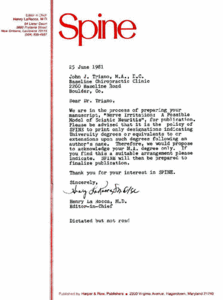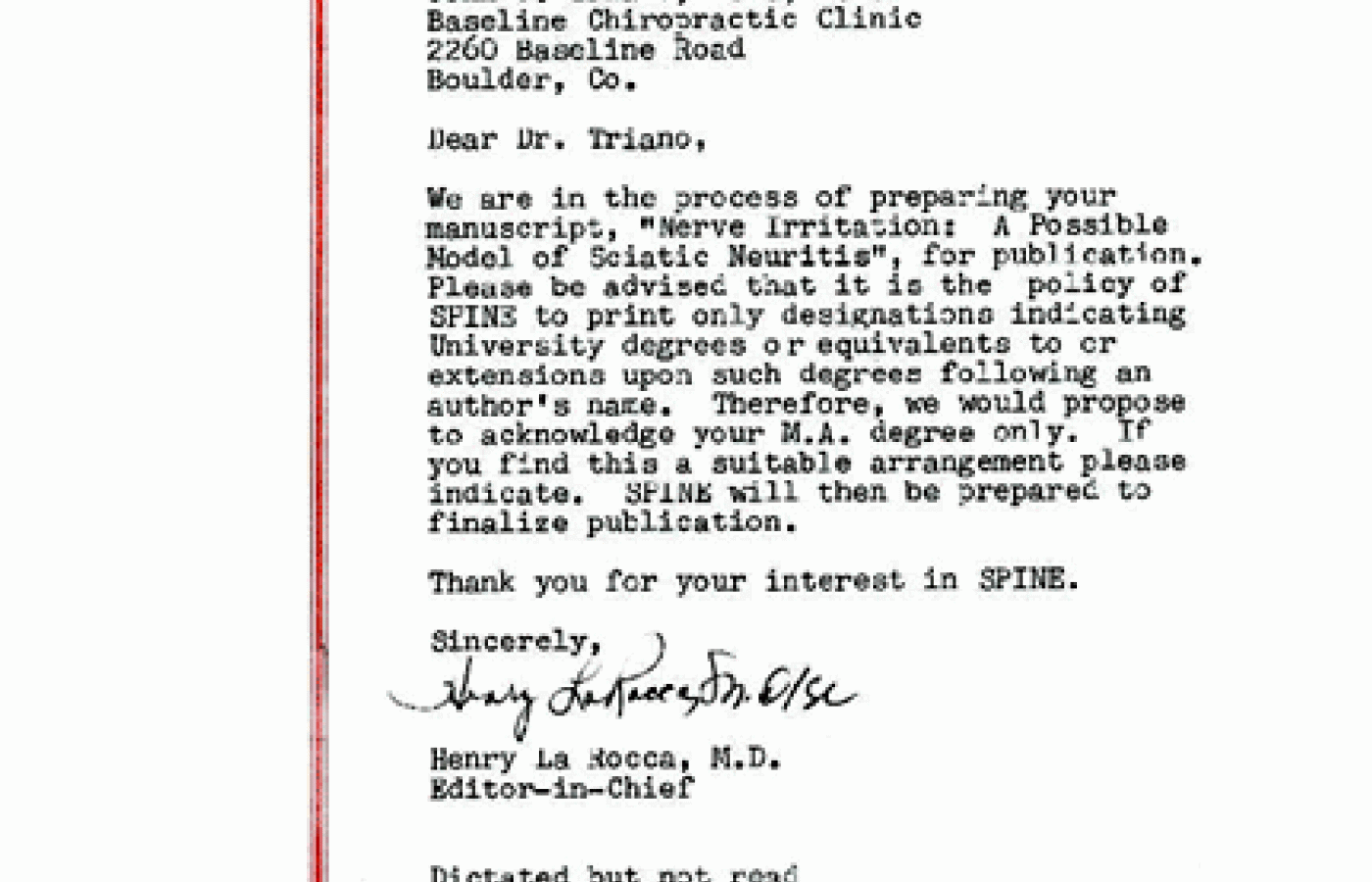Some doctors thrive in a personality-based clinic and have a loyal following no matter what services or equipment they offer, but for most chiropractic offices who are trying to grow and expand, new equipment purchases help us stay relevant and continue to service our client base in the best, most up-to-date manner possible. So, regarding equipment purchasing: should you lease, get a bank loan, or pay cash?
Are You a Change-Agent on Behalf of Chiropractic?
With the turn of the century, the opportunities for chiropractors to systematically influence patient access and the knowledge, attitudes and behaviors of medical physicians and health care purchasers toward chiropractic have increased rapidly. We are experiencing a steep demand for individuals who can bridge the gap and successfully influence opinion-makers in health policy, medicine and health-care purchasing. What would it take for you to be one of them?
Only two decades ago, the notion of medical advocacy of chiropractic care for patients was a pipe dream. No high-profile medical practices and few hospitals (and most of them financially distressed and seeking a "Hail Mary" pass to save their bottom lines) would consider employing or partnering with chiropractors. Scientific and credible clinical journals, in response to the attention caused by the 1975 National Institute of Neurological and Communicative Disease and Stroke (NINCDS)-sponsored conference on spinal manipulation, were beginning to skeptically consider articles authored by chiropractors. In the 1980s, while working with Marvin Luttges, PhD, at the University of Colorado on the topic of sciatica, I had my first lesson on the extent of intellectual arrogance and bias in medical publication. The letter I received from Henry LaRocca, MD, editor of Spine journal at the time, appears below:

A recent case in point is the SpineLine Current Concepts series, Curve/Countercurve: Cervicogenic Headache (CHA) Treatment.2 SpineLine is a peer-reviewed publication distributed as a membership benefit to over 2,500 orthopedic surgeons; neurosurgeons; physical medicine and rehabilitation (PM&R) specialists; and other members of the North American Spine Society (NASS) on a quarterly basis. Cervicogenic headache is a topic that is understood clearly and treated effectively by DCs, but still poorly recognized in the broader medical community. The Current Concepts series presents issues in the form of case presentations with a panel of invited discussants. The discussants for cervicogenic headache included one DC, two orthopedists and one PM&R doctor. Presentation of a 36 year-old man with a 14-month history of daily, unilateral headaches referred by a primary care physician to the specialist offered an important opportunity to explain how chiropractic evaluation rationally differs from typical medical examination, and how treatment logically follows. Cases are discussed in a condition-centered, patient-focused format that permits the nuances of care to be discussed openly. For example, departing from the silliness of prescriptive referral for "three chiropractic treatments" we often see from novice MDs, the article explains:
"The duration of care necessary will be influenced by the chronicity of the condition, any adaptive central sensitization and change in muscle engrams that may have occurred and patient compliance with treatment and rehabilitation plan." (p. 14)
Similarly, the influence on medical thinking from this approach at interdisciplinary interaction can be seen when the PM&R response includes:
"When SMT was compared to exercise therapy for CHA, the longer-term results were about equal, and both were better than control. The combination, however, appears to yield better results than either one alone." (p. 16)
Medical advocacy can be and is a reality, but it must be developed to reach its stronger potential for better patient care.
The pace for the 20-year evolution of change in attitude historically has proven to be typical (maybe even quick) for adoption of new attitudes in health care. What now is lagging is the evolution of large-scale change in employer, payer and local medical practitioner behavior to empower appropriate access to care. To get that, we need chiropractic change-agents who can help overcome the myths and the high-profile antics of the 16-18% minority3 of chiropractors who are so inwardly focused that they cannot get out of their own way. So, what does it take? How does it happen? What results can be seen?
First, for those who fear that this approach may somehow sacrifice their identity or philosophy, nothing is further from the truth. For most chiropractors, there is no need to markedly alter what you believe or what you do in your office with your patients. What is necessary is to learn how to talk differently about what you do. By becoming a local change-agent, you can engender more frequent and smoother patient referrals from all health-care stakeholders and foster a better understanding of the capacity for chiropractic professionalism, competence and accountability.
Becoming a change-agent takes a commitment to three simple steps. First, read and own the literature that relates to what you do. This does not mean you can list from memory all of the articles that say positive things about manipulation or chiropractic care. It means, in spine care for example, holding a current and reasonable understanding of the literature and scientific foundations for spine disorders, their natural history, pathology, imaging findings and diagnosis as well as the available literature on effects of manipulation.
Second, it is important to always be patient-centered in your approach and reference. For example, at a local medical meeting in Dallas discussing spine deformity correction, a colleague leaned over to me and asked, "Why aren't you raising the issue of chiropractic care?" My response was content-specific. The meeting topic was about deformity correction in adult scoliosis, for which there is no current evidence in the literature that chiropractic, or any other conservative management, for that matter, significantly alters the course of the condition. However, when the topic moved on to managing spine pain in scoliotic patients, it was a different story - that's a topic of great interest and opportunity. Existing evidence can be extrapolated rationally to support the chiropractic experience in such an argument. The yield is credibility, so that when you speak, you are more likely to be heard.
The third step is participation. There are a wealth of information, camaraderie and networking opportunities out there that are often ignored. Most of us complete the minimum number of CME credits necessary to maintain state licensure. Most of that is obtained strictly through programs offered by, for and through chiropractic venues. You cannot influence others if you are not interacting with them. Nearly every community has some form of health care professional meeting on a regular basis. Find them. Attend and make acquaintances. Ask relevant, topic-centered questions. Volunteer to participate as a speaker. Stay patient- and condition-focused. Naturally, bring the evidence to support what you do into the discussion as may be appropriate, but be able to discuss the indications, contraindications, pros and cons of all the usual methods to treat the condition. Make your case for chiropractic where the evidence exists and, for circumstances where evidence does not yet exist and usual care may have failed, a trial of chiropractic. Keep the arguments dispassionate, rational and anchored to the data. Showing passionate concern for patients wins; passionate advocacy of a discipline or philosophy loses.
The same principles apply for national meetings, which are worth attending. The American Public Health Association, NASS and the American Pain Society are just three examples of organizations that hold meetings at which someone in or near your community is likely a member. In addition to keeping abreast of the new developments that affect patients you see, the networking opportunities extend your credibility locally and nationally. You can become the resident expert and community resource.
How well does it work? Over the past 10 years, the experience with the Texas Back Institute alone has generated more than 100 public and professional opportunities positive for chiropractic. They have included focused write-ups on chiropractic in various popular magazines (e.g. Biography, Self, Men's Health); occasion to educate hundreds of physicians about chiropractic through formal symposia at national and state meetings; and the recruitment of physicians and case managers persuaded by professional and clinical interaction to vocally promote chiropractic in print, radio and television media.
Being a change-agent on behalf of chiropractic can expand the profession's influence and your credibility, locally and nationally. Know the literature, maintain a patient-centered (as opposed to a profession-centered) focus, and participate as a credible member of the broader health care system. Engage in the system and it will engage you.
References
- Godinez V. Chiropractors joining medical teams. Dallas Morning News, Feb 16, 2003.
- Schofferman J (section editor), Triano J, Donner J, Pettine KA (discussants). Curve/countercurve: cervicogenic headache treatment. SpineLine, May/June 2003.
- McGregor M. Elements of patient-doctor interaction: What makes chiropractic a profession. Proceedings of the European Chiropractic Union, Heidelberg, Germany, May 29, 2003.
John J. Triano, DC, PhD
Director of Chiropractic Medicine
Texas Back Institute
Plano, Texas



